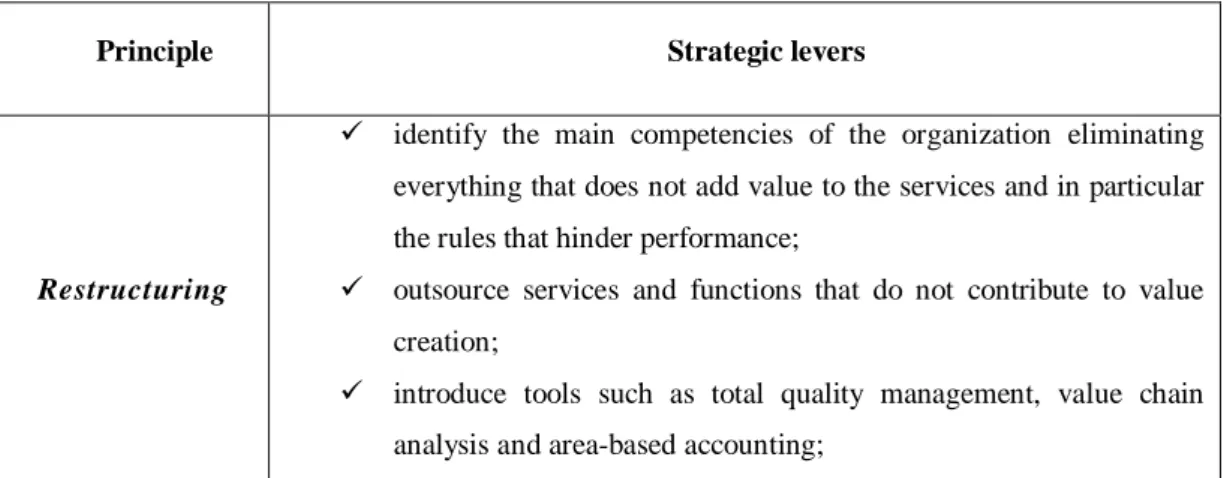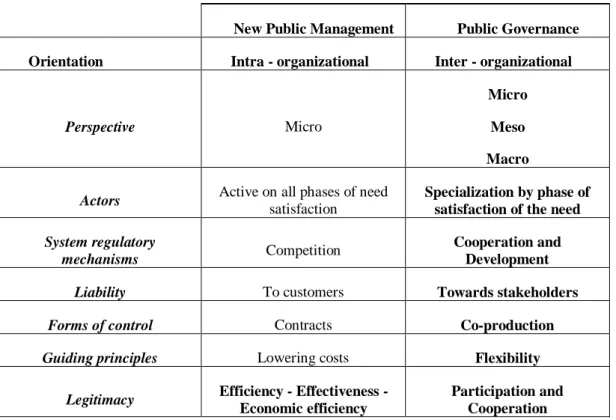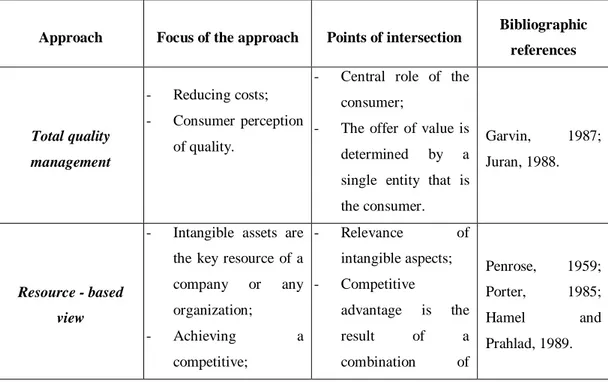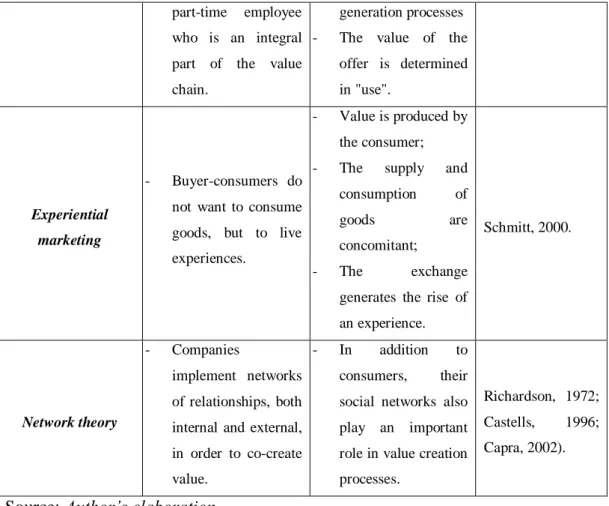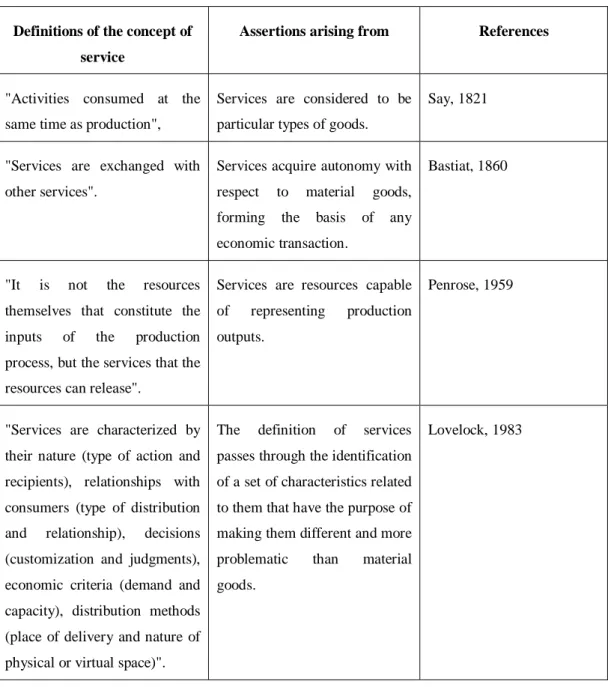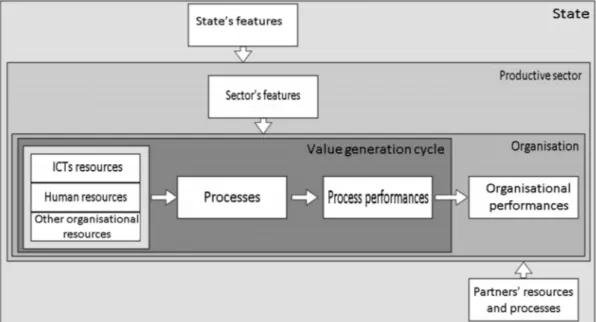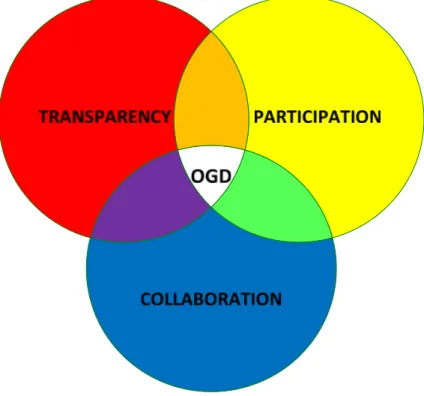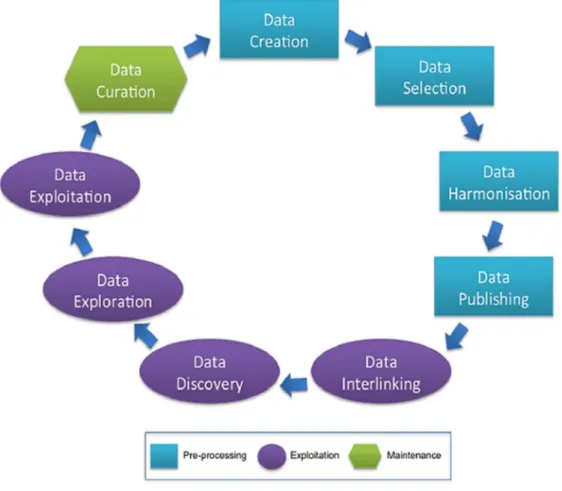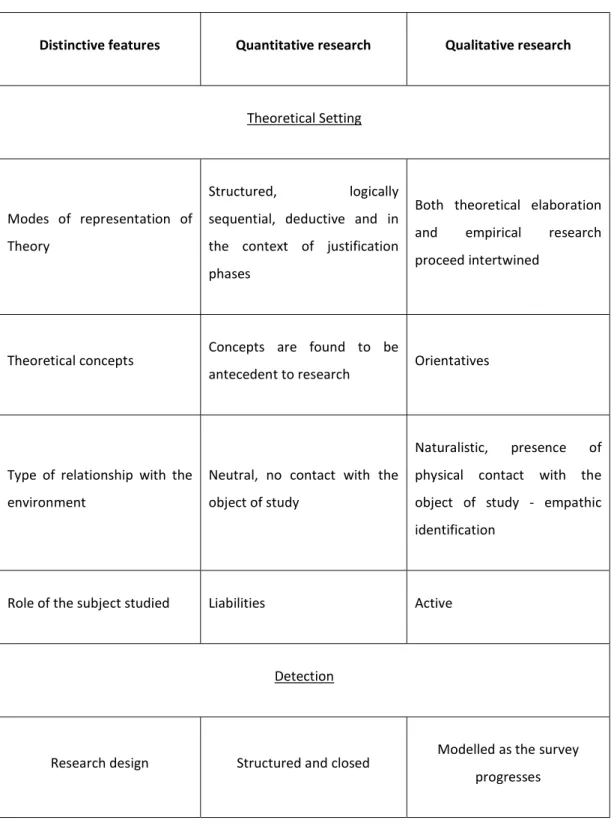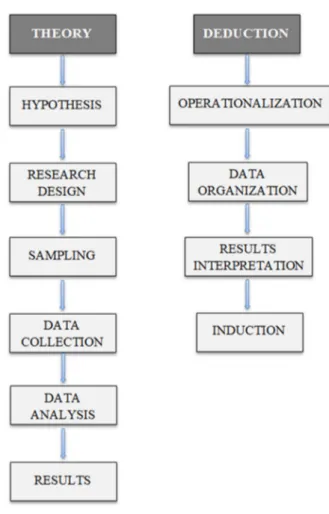UNIVERSITY OF SALERNO
Department of Business Sciences
Management & Innovation Systems
(DISA – MIS)
Ph.D. Course
Management & Information Technology
Curriculum
Economics and Management of Public Companies
Open Government Data to improve Public Service Quality:
an empirical validation through a Structural Equation Model
Supervisor:
Prof. M
ARCOP
ELLICANOCoordinator:
Candidate:
Prof. V
ALERIOA
NTONELLIG
ENNAROM
AIONEA mia MADRE.
Per l’Amore e la Forza.
Per il Coraggio, invisibile. E per la Fiducia.
Per la Pazienza, il Supporto e per l’Orgoglio.
Per i suoi Sacrifici, silenziosi.
To my MOTHER.
For Love and Strength.
For Courage, invisible. And for Trust.
For Patience, Support and Pride.
For her Sacrifices, silent.
Page
Introduction………...
1
Chapter I
Management of public administrations:
from the Bureaucratic Model to the New Public Service
1.1 Traditional approaches
………...………...
6
1.1.1 Bureaucratic Model
………...……….
7
1.1.2 New Public Management
………...………...…..
16
1.1.3 The Jones and Thompson’s 5R Model
……….…
24
1.2 Service era: service-oriented management paradigms
………...
38
1.2.1 A new concept of service
………...
47
1.2.2 The advent of the Service Economy
………
50
1.2.3 Public Value Management..
………
57
1.2.4 New Public Service
……….………
…...
62
Chapter II
Open Government Data
2.1 Towards the Open Government Data: the digital
transformation of PA……..
……….
68
2.1.1 ICTs in public administrations.
………
70
2.2 Dissemination of the Open Government Data
………...
114
2.2.1 Open Data in the Public Administration
………
114
2.2.2 Origin and evolution of the OGD
……….
119
2.2.3 The principles of the OGD: Transparency, Collaboration
and Participation
………...
121
Chapter III
Structural Equation Modeling
3.1 Methodology of social research
………..
127
3.2 Quantitative research: opportunities and threats
………
130
3.3.2 The measurement model
……….
144
3.3.3 The structural model
………..
147
3.3.4 Specification and estimation models
………...
150
3.3.5 Convergent validity and discriminating validity of
latent variables
……….……….
158
Chapter IV
The analysis
4.1 Research Design
………...
160
4.1.1 The hypotheses of the model
………...
162
4.1.2 Constructs Measurement and Questionnaire Development
…………..
168
4.3 Results discussion
………
186
4.4 Implications: theoretical advancement and managerial insights
…………...
188
Conclusion……….
194
Bibliography………..
200
the public sector push administrations towards the adoption of flexible and adaptable management models (Ashworth and Kavaratzis, 2018). Currently, the notable relevance recognized to the quality of public service in all economic, political and social contexts is shifting the attention of scholars and practitioners towards the development and deepening of new concepts of productivity, sustainability and survival (Durant and Durant, 2017).
In fact, the everyday activity of every social actor seems to be characterized by the continuous search for an improvement in the performance and level of quality of the public service. All this ends up influencing the assessments, judgments and perceptions of everything concerning the concept of public service quality, affecting the actions of those who, for various reasons, are involved in the management and governance of the Public Administration (McNabb, 2015). In this direction, there seems to be a real cultural evolution, to which different strands of research are gradually associated, paying attention to the concept of public service quality and to the importance of underlining the need to reach the adoption of management and governance models strongly oriented towards transparency, collaboration and participation of public service users (Peters and Pierre, 2016).
This shifting approach to the management and governance of public administrations has progressively led scholars and managers towards the analysis and preparation of advanced models, capable of overcoming the limits linked to the excessive rigidity and bureaucracy of traditional forms of public management and governance (Van Thiel, 2014).
Over the years, numerous studies have been conducting to highlight the logical and chronological passage that has marked the evolution of management models for public administrations (Meier, 2015; Liu and Yuan, 2015; Ni et al., 2017; Kiel, 2014). However, all the knowledge in this regard seems to be still particularly fragmentary and difficult to systematize: in literature, to date, there is no organic nucleus of empirical research aimed at investigating the factors stimulating a better perception of public service quality throughout the implementation of the several approach in the public administrations. Probably, this is due to the complexity reached in the attempt to analyze and adequately interpret the dynamics influencing the performance of public sector organizations.
Furthermore, most of the scientific contributions dedicated to the theme of public service quality are based on considerations deriving from mostly theoretical analyzes, carried out on the basis of verified hypotheses by recalling theories and paradigms lacking empirical evidence.
In this scenario, the thesis aims to provide a reinterpretation of the management models of public administrations, with the purpose of identifying a set of variables
on which managers and policy makers could opportunely leverage to promote better perception of the public service quality provided to citizens-users.
Specifically, the thesis focuses on the concept of Open Government Data (OGD) as a new approach to the management of public administrations (Pereira et al., 2017; Wang and Lo, 2016; Zuiderwijk and Janssen, 2014; Attard et al., 2015; Chan, 2013), based on the use of technologies for data treatment capable of favoring the affirmation of logics characterized by transparency, citizens’ participation and collaboration in the processes, activities and services of the public sector (Dawes et al., 2016; Gonzalez-Zapata and Heeks, 2015; Ubaldi, 2013; Shadbolt et al., 2012). In particular, the objective of the work is to deepen the aspects and conditions enabling the management of Public Administration (PA) according to the OGD, as well as the impact of this approach on the public service quality perceived by the community.
To achieve the research objective stated above, in addition to the introduction, the thesis is structured into four chapters, followed by the conclusion.
The first chapter is devoted to the literature review on the management of public administrations. More in detail, in the first chapter the main models used over the years for the management of public administrations are divided into three main macro-categories: the traditional approaches, the new paradigms and the models of the Service era. The main management models included in the category of traditional approaches include: the Bureaucratic Model; the New Public
Management; the Jones and Thompson’s 5R Model; and the Public Governance. The new paradigms include: the New Public Governance; the Network Governance; and the New Public Administration. With regard to the Service era, two approaches are examined: the New Public Service and the Public Value Management.
The second chapter focuses on the evolution that led to the birth and progressive establishment of the Open Government Data. To this end, several aspects are debated to highlight how the dissemination of this approach to the management of public administrations has occurred. In particular, attention is payed to the digital transformation of the public sector, on the role played by ICTs and other digital tools the PA, on E-Government and multi-channel concepts and on the main dimensions of Open Government Data: Transparency; Participation and Collaboration.
The third chapter describes the methodology used to carry out the empirical analysis: Structural Equation Modeling. It opens with the specification of the notion of social research methodology, placing emphasis on the opportunities and threats of the quantitative approach. Subsequently the requirements to evaluate the reliability, internal consistency and validity of the measurement scales are discussed. The chapter continues with the specification and estimation of the measurement model and the structural model. Finally, the convergent validity and the discriminating validity of the latent variables are debated.
The fourth and last chapter is dedicated to the technique of data collection and analysis conducted to achieve the research objectives. First, the research design is defined, the hypotheses of the model are formulated, the sampling and questionnaire development are explained, the data collection and elaboration are described, the findings are highlighted and subsequently discussed, the theoretical and practical implications are debated, with regard to both theoretical advancement and managerial insights.
In conclusion, wide space is dedicated to a synthesis reflection to underline the value and originality of the thesis, as well as its limits of the work on the basis of which ideas for future research are proposed, especially in consideration of the fact that the work takes shape as a first step for a subsequent scientific development, to be carried out possibly by using other complementary analytical techniques and by extending the space-time scope of analysis in order to make comparisons capable of highlighting similarities and differences aimed at underlining the robustness and generalizability of the results obtained and of the related implications.
from the Bureaucratic Model to the New Public Service
1.1 Traditional approaches; 1.1.1 Bureaucratic Model; 1.1.2 New Public Management; 1.1.3 The Jones and Thompson’s 5R Model; 1.1.4 Public Governance; 1.1.5 Network
Governance; 1.1.6 New Public Administration; 1.2 Service era: service-oriented management paradigms; 1.2.1 A new concept of service; 1.2.2 The advent of the Service Economy; 1.2.3 Public Value Management; 1.2.4 New Public Service.
1.1 Traditional approaches
Every organized human society needs rules and procedures to work and fulfill its functions. This need is even more evident in central and local public bodies, underlining the nature of the PA as an instrumental activity for the management and governance of public institutions (Antonelli, 2000, 1997). The concept of Public Administration includes all central organizations, social security institutions and local bodies. These are essentially administrations that produce goods and services not intended for sale, whose main function consists in managing and governing public and private activities.
These activities give rise to the administrative function, that is, to the set of methods used by the administration, oriented towards the pursuit of a specific
purpose. In public administrations the instrumentality of the administrative activity was initially opposed, to be then recognized only in more recent years. In fact, the factors that have contributed to the emergence of administrative systems are two (Mayntz, 1978):
the concentration of power within a specific and delimited territory;
the presence of objectives requiring the collaboration of a plurality of individuals.
1.1.1 Bureaucratic Model
The situation described above has led to the consolidation of principles with a strong institutional content, reflected in the model of bureaucratic government (Borgonovi, 2005). The bureaucracy was born as a sort of operational arm for the pursuit of the goals of public administrations. It has represented the most typical organizational phenomenon of modern society which has placed the process of bureaucratization in close connection with the rationalization, within the broader process of modernization.
The moment of maximum expansion of the Bureaucratic Model took place within the Enlightenment culture, where the main emphasis was focused on the paradigms of absolute rationality, perfect symmetry of knowledge and transparency.
The first social scientist who exhaustively analyzed the concept of administration is Max Weber, who framed the bureaucracy in the process of rationalization that has affected the history of the West (Mayntz, 1978).
Max Weber and his followers have associated the analysis of the Bureaucratic Model to the development of legitimate power and its various manifestations in
charismatic, traditional and legal-rational power. What distinguishes the three types of power proposed in the Weberian conception is the criterion on which the claim of legitimacy of power is founded, which can come:
from the belief in the skills and personal charisma of those are in power (charismatic character);
from belief in the sacred character, from the rightness of tradition and from the legitimacy of those who are called to exert power (traditional character);
from the belief in the legality of a system of impersonal legal orders (rules and procedures) and the right of command of those who are called to exert power on the basis of laws (legal power).
The practical exercise of power requires the presence of an administrative apparatus that acts as a "trait d'union" between holders of power and recipients. According to Weber, the administrative apparatus of legal-rational power is the bureaucracy, which is characterized for the aspects linked to the organizational structure and function, to the means by which workers are rewarded and to the benefits of the individuals employed in the organization. The most characterizing element of the Bureaucratic Model is the assumption that the rationality of the logical system allows for the control of the quality of results and processes.
However, the same scholars who have theorized it show that it is an abstract model of reference to which public and private organizations should tend. In fact, the reality within which organizations operate is very different from ideal models and, on the other hand, the subjectivity of the person can only be contained but not completely eliminated. According to the Weberian conception, the more unpredictable, uncontrollable and non-judicial component of subjectivity is contained, the more the space destined for the rationality of the social organization grows.
Therefore, according to Weber and his supporters, to make the activities of organizations efficient and effective, it is necessary to control the organizational structure through rules and procedures that allow predicting the workers’ behavior. Weber emphasized the importance of the Bureaucratic Model by arguing that the achievement of the set goals is simpler whether the arbitrariness and opportunities for conflict in interpersonal and social group relationships are eliminated.
The German sociologist believed that the business purposes should be pre-established by the law and by the rigid use of the rules (prescriptive legislation). The plurality of specialized roles requires, however, strong coordination structures that constitute the premise of the hierarchy, which increases proportionally to the dimensional growth of the organization.
The Bureaucratic Model played an important role especially in the first phase of the development of modern enterprise, giving particular emphasis to aspects related to the specialization of work, as well as reducingthe importance of relations between tasks, functions and final results of processes. In this model the decision-making area is managed only by the top management, while the middle management is entrusted with control of the precise execution of the tasks to be performed by the executive staff, verifying the strict compliance with the procedures.
Weber (1964) does not define the bureaucracy but, rather, tries to identify its main characteristics that make it the most efficient form of administration. In the Weberian conception, organizations and enterprises are characterized by:
a hierarchical principle, according to which every manager answers to his/her superior for all the decisions taken by him and his/her subalterns;
a formal system of stable rules and regulations aimed at ensuring the achievement of uniformity of actions and decisions;
a division of labor (responsibilities or duties of the office) and a high level of specialization, making use of people with the required technical qualification. In fact, to each office an area of competence and responsibilities is assigned but the deriving power belongs to the office and not the person to whom it has been entrusted;
impersonality in external and internal relations, which avoids the interference of feelings in the rational fulfillment of official duties;
a vision of work both as a profession and as a career. Many bureaucratic offices provide lifelong employment and this translates for the official into a certain level of job security and increasing salary through automatic promotion procedures based on merit and seniority.
The characteristics described above make possible to identify the pillars of the Bureaucratic Model in the following elements: rationality, neutrality, hierarchy and competence. Rationality implies that the bureaucrats put into practice the rules coming from the political decision-makers according to a rational method that satisfies decisions; neutrality shows how the bureaucracy is disconnected from other powers, such as the political one, because the task is to produce impersonal rules valid for the reference subjects; the hierarchy, on the other hand, makes possible to highlight how bureaucracy is organized in a way that enables each position to be higher or lower than another one (vertical model); finally, competence reinforces the bureaucracy thanks to its specialized knowledge. The bureaucrats are part of it because they demonstrate to know, through certain procedures, that knowledge. Therefore, the Bureaucratic Model promoted and supported by Weber identifies a strong link between power and administration. In fact, if on the one hand power is manifested and acts as administration, on the other hand every administration requires power. The existence of an administrative apparatus is consequently one of the factors most intimately
connected to power relations. The other factor linked to power is legitimacy, since every power tends to arouse and cultivate faith in its own legitimacy.
The growth and evolution of this model are dependent on several factors, such as: the affirmation of the monetary economy; the pressures deriving from the various social groups with the affirmation of democracy; the static environment; the pushes coming from the bureaucrats; the specialization of administrative bodies.
The combination of these factors has determined and implemented the model that for years has represented the modus operandi of public sector organizations and in which the following characteristics are defined: elementary technologies and simple/basic decisions.
In such a model, the manager mainly uses authority and control. In other words, uniqueness comes to delineate both in terms of command and authority. In fact, the manager, also called "boss" has the authority, responsibility, control of the activities carried out by employees and holds complete knowledge. The "boss", in other words, is responsible for the objectives and results, imposes his/her own decisions and monitors the operations performed. According to Weber (1964) the "boss" thinks, knows and decides, while the employee obeys since he/she has to do the "things" by who has authority.
Therefore, in the bureaucratic decision structure, employees are subject to stringent top-down control. Therefore, in the Weberian conception, the Bureaucratic Model was considered as the most efficient and effective form of public institutions management since it was based on the possibility of reducing the discretion of people, referring only to compliance with formalized and pre-established procedures.
The theories formulated by the German sociologist were later taken up by other scholars. In fact, until the end of the 80s the public sector was organized and managed according to the characteristics of the traditional Bureaucratic Model
(Weber, 1980), founded on a vision of the public institute that correlated the nature of public action almost exclusively to the respect formal legality and the presence of guarantees aimed at preventing negative behavior with respect to public purposes, rather than promoting proactive behavior (Borgonovi, 2002).
In that context, where the efficiency and effectiveness of the activity would have been theoretically guaranteed through the correct and timely execution of the tasks to be carried out in an impartial and neutral manner, it becomes clear that the crucial competences were those related to the respect of legality, the meticulous knowledge of legislation and procedures, as well as the possession of a high specialization on individual aspects. Some of these characteristics have remained as acquired in the modus operandi of PA but, with the entry into crisis of the Bureaucratic Model, other scholars highlight its limits theorized by the German sociologist and his followers.
However, over the years, Weber's conceptual approach has been criticized. In fact, several scholars have stated that the German author and his followers had omitted to consider two particularly relevant aspects: the opportunism that often characterizes human action and the limitation of information held by those called to control compliance with procedures and management rules (Brosio, 1996).
According to a similar consideration, Merton (1970) in saying that "... chickens are trained to recognize in the sound of a bell the signal of announcement of food but this sound can be used, in a second moment, to attract and kill them...", emphasized how sometimes the respect slavish rules, under certain conditions, could prove dysfunctional in relation both to the pursuit of the proposed goals and to whom the bureaucracy should serve.
According to Merton, the absence of ductility, in occasion of changed environmental conditions, determines an inability to adapt and therefore an unproductive fossilization to the mere respect of procedures and rules. It follows
that adherence to the rules seen first as a means, then becomes an end in itself, transforming the structural value into the final value. All this translates into inability to adapt, rigidity, fussiness, technicality, hindering the purpose and purpose of the organization. In fact, the bureaucrat who is increasingly oriented towards compliance with discipline and rules places too much emphasis on regulations, generating uncertainty in decisions, a conservative mentality and accentuated technicality. Moreover, in order to defend their status, which is based on full compliance with rules and procedures, officials tend to hinder any change in practice that could compromise or harm their interests.
This explains why many regulations, originally introduced for technical reasons, tend to become rigid and sacred even when they are obsolete. This trend also leads to a certain depersonalisation of the relationship between civil servants and users, as problem-solving officials minimise personal relationships, always trying to address issues in the same way, categorising users abruptly.
Other scholars focus on the dualism between hierarchical discipline and professional competence, supporting the existence of a plurality of models represented by different types of democracy: apparent, impositive and representative (Gouldner, 1954). In apparent democracy, the rules are determined by an external structure and are ignored by both managers and employees; in the tax system, on the other hand, one party decides the rules with respect to the others and, finally, in the representative model, the rules are shared, that is, determined by the managers with the participation of the other parties.
Other scholars argue that the increase in specialisation, proper to the bureaucratic model and to the delegation and independence given to experts, can lead to the emergence of sub-groups whose objectives may differ from those of the organization (Selznick, 1966). Selznick's studies and analyses led to results that were mirrored in a series of considerations:
the existence in formal organisations of forces built to pursue certain aims;
the organization has to meet some basic needs in order to survive;
the adaptation of the organisation has to be seen in terms of the needs to be met;
the organization has to be seen in a twofold direction, both as a fundamental tool for the pursuit of an objective and as an element that deforms the objective to which it tends.
In the light of these considerations, Selznick goes so far as to support the ambivalent nature of the institution, where at the upper level there is the organization, as a tool designed to perform a job, and at the lower level there is the institution, closer to the needs of society.
In the literature of organizations, the bureaucratic model has been criticized for the lack of attention paid to the non-formal component, highlighting the excessive importance given to form, rather than substance (Crozier, 1969). In fact, the bureaucracy, being excessively formalistic, not only in the relationship with the users but also in the organizational criteria, ends up pursuing the only purpose of carrying out the tasks, with the consequence of putting in second place the competences and the subjective aspects. Argyris (1964) and his supporters state that bureaucracy reduces the psychological growth capacities of individuals causing feelings of frustration, failure and conflict, suggesting that the organization should leave sufficient individual responsibility, a certain degree of self-control, a work performance in line with the goals of the organization, productivity and an opportunity for individuals to fully apply their skills.
According to Caulkin's studies (1987), the impersonal structure of bureaucracy is considered as a form built more around the place than the person, in which the focus is placed more on processes than on objectives, thus determining a deviation between the activity of individuals and the objectives they are called to pursue. Therefore, numerous studies highlight the existence of certain limitations of bureaucratic management due to its different connotations. As for the rational Weberian method, the limits are:
inability to choose appropriate means of achieving the objectives set: the bureaucrat is satisfied with the first most satisfactory solution (limited rationality);
Inconsistent incrementalism: bureaucrats refer to some possible solutions and try them out until they find the most useful one;
neo-institutionalism: organisations are not only functional apparatuses, but also holders of specific values and wishes (March and Olsen, 1997).
asymmetrical political/bureaucratic relationship, according to which politics can live without bureaucracy but it is not worth the opposite;
autonomy of the bureaucracy: out of the sphere of political influence, the bureaucracy not only carries out but plans and decides, placing itself in conditions of negotiation and no longer mere execution in the relations between the political and the social sphere in which citizens operate.
Bureaucracy also acts by subverting the hierarchical sphere. In fact, lower levels have often different tasks than higher levels with specific skills. The existence of these limits has gradually led scholars and experts to identify appropriate processes of reform of the Public Administration, recalling new concepts, opposed to those ones of the Weberian vision. Several elements of change in bureaucracy
have progressively emerged, such as deregulation (reduction of Public Administration rules leading to less present public intervention), privatisation (public space is reduced by giving more emphasis and importance to results) and transparency (citizens demand greater accessibility to documents, greater possibilities to interact with bureaucracy and greater control of efficiency).
1.1.2 New Public Management
At the end of the 1970s, economic and social changes prompted industrialised democracies to seek new ways of increasing competitiveness in the public sector, leading them to adopt the New Public Management (NPM) model (Gualmini, 2003). This reform movement has spread in the public administrations of various Countries and is characterized by the tendency to apply criteria for their management similar to those ones typical of private companies. Therefore, the expression "corporatization of public administrations" is used to define this reform process, which was also initiated in Italy in the 1990s, and which has brought the management methods of the "public thing" closer to those of private organizations (Pozzoli, 2009). It is not easy to define in detail the characteristics of the NPM, since there is no unitary body of theory from which it draws (Adinolfi, 2003). According to some authors, this current of thought represents "the third great revolution of the modern economy after the industrial and technological ones" (Hinna, 2009), to the development of which several international institutions (OECD, World Bank, IMD, World Economic Forum) have contributed effectively.
This innovative process starts from the negative and unsatisfactory results in terms of economic performance and services provided due to the rigid application of the bureaucratic model unsuitable to face the economic-social changes that
were progressively characterizing the Public Administration (Poggesi, 2006). The NPM can be qualified as a "pragmatic approach" based on very simple assumptions: the relaunch of the economic system requires high levels of efficiency and productivity of the public sector that can be achieved by introducing managers from the private sector, able to bring to the public sector culture, methods and techniques successfully tested in the private sector. The basic idea is to integrate the administrative law governing the operation of a public body with more result-oriented management methods with the aim of ensuring greater cost-effectiveness, efficiency and effectiveness in the management of public services.
A fundamental characteristic of the NPM is the application of managerial techniques, typical of private companies, in order to increase effectiveness and efficiency in the production of public services. The new paradigm emphasizes not the simple transfer to Public administrations of managerial logics and techniques traditionally employed in the private sector, but rather the principle according to which both public and private organizations must seek the best economic conditions to obtain higher quantitative and qualitative levels of results, given certain resources (Borgonovi, 1988). Therefore, the managerial function exercised within public companies is not merely oriented towards maximizing purely economic purposes but the search for better conditions for the execution of institutional functions through an efficient use of resources suitable to promote a physiological survival of institutions and Public Administration (Borgonovi, 1988).
This model is based on rational public management, a pervasiveness of value assumptions and an interest in maximising efficiency within the Public Administration (Girotti, 2007).
One of the main characteristics of the NPM is the great importance it attaches to the development of performance indicators for Public administrations that make it possible both to verify the results a posteriori and to provide stimuli for management that better correspond to the expectations of the communities of reference (Hood, 1995, pp. 95-98). Hood (1991, pp. 4-5) identifies seven elements to describe this paradigm: 1. the recognition of the professional character of Public Administration passes through the attribution to managers of greater responsibility and autonomy in the form of managerial skills; 2. the adoption by the Public Administration of parameters and indicators of evaluation of the activity in terms of quality and efficiency; 3. control of the outputs and services provided; 4. the tendency to disaggregate the operating units in the Public administrations; 5. the adoption of private-style management practices typical of companies that favour competition and competition with the private sector; 6. the use of parsimony in the allocation of resources; 7. the strengthening of self-regulation by public employees.
Osborne and Gabler (1992), argue that the Public Administration, in addition to leading, coordinating and providing services, must increase its internal competitiveness by focusing on performance. In addition, they believe that Public Administration should be modernised through the empowerment of managers and the recognition of the citizen as a client of a service provided by an entrepreneurial administration. In fact, according to the authors: "... the type of government that developed during the industrial era, with its centralized and slow bureaucracies, their attention to rules and regulations and their hierarchical structures, does not work very well ... They have achieved a lot in their day, but over time ... they have become superabundant, wasteful and ineffective. And when the world began to change they failed to change with it. ... The hierarchical, centralized bureaucracies designed in the 1930s and 1940s do not work well in the rapidly changing, information-rich, knowledge-intensive society and economy of the 1990s" (Osborne and Gabler 1992, p. 112). According to the authors, New
Public Management would propose itself as a single vision common to all countries, beyond the individual applications and administrative cultures, to overcome the current crisis.
The NPM represents a new way of studying and managing public organisations. Ferlie and Steane (2002) summarized with great effectiveness the essential aspects of the NPM with the trinomial: manager, market, measure, considering them the key principles of this model. Adcroft and Willis (2005, p. 387) stressed that an important aspect of this approach is the possibility of transferring successfully tested management techniques to other contexts in Public Administration management. Ferlie and Steane (2002) analyzed the reforms introduced in Europe, North America and Australia in the 1980s and 1990s in the spirit of New Public Management.
For Adinolfi (2005), the aim of the NPM "is not to study public organisations in a disinterested and detached way (as is the case in most social sciences) but to study them in such a way as to help operators find solutions to their problems or improve the functioning of the organisations they manage".
In this sense, new tools and structures have been introduced, the culture of management control and measurement of results has established itself, systems for evaluating managers have been implemented. In other words, we have witnessed an attempt to introduce, disseminate and root in the public sector corporate management criteria in the belief that the public sector can and "should" learn from the private sector, borrowing from the latter tools and operating logic that make it superior in terms of performance and performance.
Anselmi (2003, p. 168) pointed out that in Italy, too, in the 1980s, efforts were made to overcome the "traditional" bureaucratic model, in which the activity consisted mainly in the application of standards, towards management methods dedicated to the evaluation of results (performance management). In this
perspective, even the PA as a private company creates value when using resources in order to best meet the needs and requirements of potential customers. According to Moore and Khagram (2004, p. 5), the most important difference between private companies and Public administrations is that private companies obtain a large part of their financial resources from customers who voluntarily pay to purchase their products, while Public administrations obtain them mainly through the taxation decided by the legislative power. Other important differences are the following: the behaviour of users of public services often has a decisive influence on overall performance, particularly in terms of health protection, education and public order; citizens generally attach great importance not only to the quality and cost of public services, but also to fair distribution and the fairness of the processes used by Public administrations to carry out their activities.
The New Public Management, arguing that the P.A. can regain its legitimacy by adopting the logic and tools of private companies (Stewart and Walsh, 1992), considered able to meet the needs of its market of reference in an efficient and effective way, has given more and more importance to the demands coming from the citizen, perceived as a customer and not as a simple user (Fiorentini, 1990). In 1993 in the United States, a great reform momentum in the public sector took place at the beginning of Clinton's presidency. In particular, it began to entrust private companies with the management of some public services, paying more attention to the needs of users of public services, considered customers of the Public Administration. This stimulated the spread of benchmarking practices and quality control methodologies similar to those adopted in private companies. Reforms of public accounting systems were initiated and principles similar to those of private companies were introduced, with the aim of extrapolating important economic performance indicators. Finally, tariffs were introduced for some public services that could cover a significant part of production costs.
The approach of New Public Management has involved, in particular, greater attention to the expectations of users of public services, in the years in which several scholars of business administration, developing the insights of Eccles (1991) and Kaplan and Norton (2001), stressed the need for private companies to pay attention to customer satisfaction, also in order to effectively pursue in the long run strategies to maximize value for business owners. According to Dunleavy et al. (2006), the three main directives of New Public Management are: 1) disaggregate, 2) compete, and 3) incentivise.
According to Osborne (2010, p. 1), New Public Management can be considered as a transition phase in the evolutionary process from the traditional or Weberian Public Administration paradigm towards New Public Governance. According to Osborne, the implementation of public policies and the provision of public services have gone through three stages: the traditional Public Administration from the end of the 19th century to the early 1980s; the New Public Management from the early 1980s to the beginning of the new millennium; and, then, that of the emerging New Public Governance. New Public Management would therefore have represented a relatively short phase of transition from the statist and bureaucratic tradition of the traditional Public Administration to the pluralist tradition of New Public Governance, even if significant elements of these three regimes often coexist and overlap. Typical characteristics of the traditional Public Administration, as already discussed in detail in chapter 1, are represented by: 1) prevalence of the principle of legality, 2) attention to administrative rules, 3) the central role of bureaucracy, 4) the separation between politics and administration in public organisations, 5) the prevalence of incremental budgets, 6) the hegemony of professionalism in the provision of public services. This vision had its peak during the period of strong expansion of the welfare state between the 50s and 70s of the twentieth century; it went into crisis towards the end of the 70s as the awareness of the scarcity of resources available in relation to people's expectations in terms of public services spread.
According to Osborne (2010, p.5), neither the traditional Public Administration paradigm nor the NPM paradigm is able to grasp the complexity of the processes of defining, managing and delivering public services in the 21st century. In a nutshell, according to Osborne (2010, p. 9), while the traditional Public Administration paradigm focuses on the political system and New Public Management on the organization, the focus of New Public Governance is on the organization and its environment. The mechanism for allocating resources is: the hierarchy for the traditional Public Administration; the market and the classic contract for the NPM; networks and relational contracts for New Public Governance. In fact, the problem of the evolution from NPM to New Public Governance has been present in the analysis of business economists since the early 1990s.
The philosophy of the NPM has sought to be accredited as an example of good government for Public administrations by calling for universal applicability. However, the results of government plans to introduce NPM principles and techniques have often not lived up to expectations. The disappointment about the results obtained is - not without reason - interpretable as difficulty in overcoming the traditional bureaucratic model or as uncertainty about the ways of technical articulation and implementation of the NPM (lack of attention to the "implementation" and the critical success factors). In fact, there is a conceptual forcing in the philosophy of the NPM when it assimilates tout court the management of a Public Administration to that of a private company. If the limits of the NPM lie in its ambition to transfer the logic of the business world to the public sector in a "quasi-automatic" and uncritical way, it is necessary, in order to rationalise the functioning of Public administrations, to start from the recognition of the elements that characterise (or should characterise) their nature in specific terms.
There have been several criticisms of the NPM, considered too close to the world of private companies, not very critical and unable to highlight the specific decision-making and management of the P.A. In particular, criticism has come from what is called the Traditional Public Administration movement. According to these opponents of New Public Management, privatization prevents teamwork in the administration and cancels out the ethical dimension of public decision making. Moreover, public service management differs fundamentally from the private sector in terms of objectives, context and performance constraints. Analysing the reports presented at the Conference of the European Group of Public Administration (September 1995), of the International Institute of Administrative Sciences, on "European and American Approaches to Public Management", Meneguzzo (1995, p. 492) identified two lines of research on Public Administration, one directly referring to the NPM paradigm, the other connected to the definition of a specific paradigm of Public Governance, which starts from the conviction that the NPM is too close to the world of private enterprises and not able to take into account the specific decision-making and management of Public administrations. In particular, Meneguzzo analyzed the contributions of Kooiman and Van Vliet (1993), aimed at overcoming in some ways the paradigm of New Public Management in the direction of New Public Governance. According to Kooiman and Van Vliet, internationalisation, environmental protection requirements, technological development and a culture of individuality require innovative ways of governing and coordinating socio-economic systems, based on the interaction between government and society, between public and private, and on the emergence of a different relationship between decisive and managed interventions at the political-administrative level and forms of self-organization at the social level. The basic assumption of the New Public Governance is represented by the need to start from the external environment to define the policies of organizational development and managerial requalification addressed within public organizations. In this regard, Kooiman and Van Vliet distinguished three different areas of public management: micro level
(single public organization), meso level (system of companies and public organization), macro level (overall socio-economic system).
1.1.3 The Jones and Thompson’s 5R Model
To understand the NPM, a useful reference framework is the Jones and Thompson
5R model (1997) which identifies the operational tools for its strategic implementation. The authors argue that implementing the model would help to make public management more responsive, more transparent, more effective and more efficient. It is, therefore, a project model capable of facing the challenge posed by the reforms and strongly oriented towards the realization of a series of profound political, structural and cultural changes.
The table below summarises the basic principles of the 5Rs and the coherent strategic actions for each principle.
Table 1: The 5R model
Principle Strategic levers
Restructuring
identify the main competencies of the organization eliminating everything that does not add value to the services and in particular the rules that hinder performance;
outsource services and functions that do not contribute to value creation;
introduce tools such as total quality management, value chain analysis and area-based accounting;
Redesign
reconfigure activities rather than adopt marginal solutions;
to encourage computerization through the use of modern computers and information technologies;
build bottom-up processes;
to increase the quality of the services rendered and at the same time to encourage a reduction in time and costs;
introduce modern tools, such as databases; group work; benchmarking; imposition of time cycles.
Reinvent
develop new planning processes; identify new service/market strategies;
introduce new tools, such as strategic planning, market research, target costing, networks and alliances.
Realign
align the administrative structures and responsibility centres of the body with the new service/market strategies;
align the control/award structure of the organisation with the administrative structure and the centres of responsibility;
to give importance to the operations centers;
introduce performance-based organizational tools, budgeting and accounting for responsibility centers, incentives.
Rethink
accelerate the cycle of observation, orientation, decision making and action, both to improve performance and to learn more quickly;
giving more powers to "frontline" employees to assess service performance and provide feedback on service strategy and delivery;
build an organization that learns and adapts;
introduce new instruments, such as decentralisation, flexible controls, working capital, rapid analysis and learning models.
1.1.3 Public Governance
Of Greek-Latin origin, the Anglo-Saxon term "governance" indicates the art of driving and since the classical age is expressly used to denote the ability to indicate the route to follow (Schneider, 2002). To date, it is difficult to find a single definition of governance, since the excessive use in various sectors does not allow to trace the precise boundaries of the scope of the concept (Vedelago, 2002). In recent years, the word has gained further notoriety precisely because of its conceptual vagueness and the interpretative flexibility inherent in it which, however, on the other hand, have led to a loss of precision in its meaning (Cepiku, 2005).
Governance represents a multi-dimensional concept, whose semantic flexibility has allowed its adoption in different contexts: if in companies it has been identified with the name of "corporate governance", in Public administrations it is called "public governance", while in international institutions it becomes "global governance" (Antonelli, 2010; Hinna, 2009).
Corporate governance refers to the mechanisms, processes and relationships through which companies are controlled and directed (Shailer, 2004), a set of procedures related to the decision-making process by which a board of directors ensures responsibility, fairness and transparency in the relations of a company with its stakeholders: lenders, customers, managers, employees, government and communities (Baums et al., 1994; Shleifer and Vishny, 1997).
Public governance is the set of mechanisms through which a nation, a region or a city pursues and creates a certain social order. In particular, in the public sphere, there is a particular focus, rather than on the actions of individual actors, on the relations that are established between them (Kooiman, 1993), placing the perspective of networks as the one to follow (Cepiku, 2005).
Finally, the ever-increasing international interdependence, combined with the persistence of fragmented cultural, political and social realities, leads to the need for global governance, i.e. a form of global regulation based on self-managed and self-organized networks (Rosenau, 1997; Keohane, 2002; Makinda and Okumu, 2008).
The three conceptual dimensions of governance, applied in different fields, are not to be considered as isolated. On the contrary, they intersect and condition each other, defining principles and models of implementation, one by virtue of the other. We are faced with the application of business principles and models within Public administrations, as well as the integration, within private contexts, of national disciplinary laws (Cepiku, 2005).
Several scholars of public management (Meneguzzo, 2008; Hinna, 2005; Adinolfi, 2005) highlight the poor implementation of the principles of the NPM, which, more than being a new paradigm, has turned out to be a current of thought, surpassed by the debate of Public Governance (Hinna 2009; Polidano and Hulme, 2001).
This theoretical vein has been the subject of wide debate in national and international literature and has been used to describe the processes of change and modernization underway in Public administrations (Kooiman, 1993; Bekke et al., 1995; Rodhes, 1992; Minogue et al. 1998).
Public Governance, which according to Meneguzzo (1997) was established in the 1990s to fill the already discussed gaps in New Public Management (Bekke et al., 1995)
The theory, therefore, challenges the incessant search for technicality by the scholars of the NPM (Adinolfi, 2005), focusing instead on concepts such as participation and accountability, placing the centrality of the citizen-user at the
center of the government process. Other central aspects of Public Governance are: the ability to create shared visions on development prospects, lifelong learning, market opening, the participation of the various components of the social and economic system.
The following table highlights the main differences between the two paradigms.
Table 2: The differences between NPM and PG
New Public Management Public Governance
Orientation Intra - organizational Inter - organizational
Perspective Micro
Micro
Meso Macro
Actors Active on all phases of need satisfaction
Specialization by phase of satisfaction of the need
System regulatory
mechanisms Competition
Cooperation and Development
Liability To customers Towards stakeholders Forms of control Contracts Co-production Guiding principles Lowering costs Flexibility
Legitimacy Efficiency Effectiveness -Economic efficiency
Participation and Cooperation
Source: Adapted from Cepiku (2005) and Poggesi (2006).
The key idea on which Public Governance is based is to go beyond the concept of
government in favour of that of governance. The logic of Public Governance, in
fact, is linked to development models based on the concepts of participation and cooperation. The theoretical basis on which Public Governance is based is that the mission of public organizations is not limited to the efficient production of public
services aimed at minimizing costs and maximizing revenues, but in the ability to build relationships between Public administrations and social partners, as well as in the choice to privilege a development based on knowledge, skills and innovations.
Typically, governance can be defined as a specific guideline for the resolution of common public order problems. Strictly speaking, this implies a redefinition of the role of the citizen, who from being a passive consumer of public services becomes an active participant (Lappe and Du Bois, 1994). Governance refers to a new type of coordination mechanism, which is an alternative to "market anarchy" and "organisational hierarchy" (Amin and Hausner, 1997; Jessop, 1997; Rhodes, 2000). Note that unlike government, whose activities are supported by formal authorities, governance refers to activities supported by shared objectives that may or may not arise from legal and formally prescribed responsibilities (Rosenau, 2000). Therefore, governance seems to be a more pervasive and all-embracing phenomenon than government, since it "embraces the concept of government, but also assumes informal, non-governmental mechanisms [...] thus it is possible to conceive of governance without government, a set of regulatory mechanisms in a sphere of activity that functions effectively even though it does not have formal authority (Rosenau, 1992, p. 5).
Such a circular logic of participatory and responsible administration presupposes that public organisations are at the centre of a widespread network of relationships, playing a "light direction" role (Anselmi, 2003). With the emergence of Public Governance, the paradigm, the strategic approach of the P.A. evolves bringing three aspects to the center of attention of the P.A. (Meneguzzo, 1997): 1) the relevance of the interactions with the actors present at the various levels of the social policy context; 2) the governance and coordination of complex networks in the social system; 3) the external orientation, especially towards the social economic environment.
It seems of great interest to broaden the perspective occurred in parallel with the transition from the NPM to Public Governance, because this puts into play a set of areas, previously neglected, such as public policies, public service delivery, participation and involvement of citizens, all dimensions that go hand in hand with the focus on internal management (Badinelli et al., 2012; Barile and Polese, 2010; Barile et al., 2014).
According to Public Governance, management has the task of exercising its functions independently of political influence. Often, however, in practice, the role of the manager cannot be completely dissociated from this influence and their function is thus compromised (Barile et al., 2013; Ciasullo et al., 2016; Mele and Polese, 2011).
In so doing, the term governance is seen as the result of the joint efforts of a plurality of actors belonging to the same socio-economic system. According to Rhodes (1996), the term in question has been given a number of meanings that have undermined its usefulness. For the author, governance refers to
self-organizing, interorganizational networks, of which he identifies the following
determining elements: the interdependence between organizations; the continuity of interactions between network members; game interactions; the significant degree of autonomy from the state.
According to Kooiman (1993), governance coincides with the scheme or structure that emerges in a socio-political system as a common outcome or result of the interactive efforts of all actors involved. This pattern cannot be reduced to a single actor or group of actors in particular.
In contrast to a bureaucratic culture centred on formal procedures and insufficient attention to the external environment, the model of Public Governance projects the P.A. towards a decentralized structure based on participation, networking and forms of partnership. Specifically, the widespread awareness on the part of Public
administrations to start from the external environment to define public policies, and consequently to activate innovative governance methods based on the continuous collaboration between the institution and civil society, better denotes the concept of governance1.
The framework in question requires Public administrations to integrate the action of local public authorities with a wider mobilisation of actors of different types. This inevitably involves the drafting of a project that is shared by the various local actors, able to make public initiatives and policies synergic, promoting a style of government characterized by a greater degree of cooperation and interaction between public and non-public actors (Mayntz, 1999), with interactions of "play", based on trust and governed by rules negotiated and agreed between the participants (Rhodes, 1996).
Public Governance is therefore characterised as a "process of elaboration, determination, implementation and implementation of policy actions, conducted according to criteria of consultation and partnership between public and private or third sector subjects" (Segatori, 2002).
In conclusion, summarizing the brief review carried out so far, we can list the following founding principles of a system of Public Governance (Kickert, 1997): 1) general orientation of the P.A. towards the external environment (community,
1 The term "governance" has different meanings. You can track at least six of them: (i) as a
minimal state, as a consequence of the reduction in the scope and form of public intervention and the use of market and quasi-market systems for the provision of services; (ii) as corporate gevernance, i.e. a system through which organisations are governed and controlled; (iii) as New Public Management, with reference to the introduction of new mechanisms (such as the market) for the provision of services and the separation between decision-making and production activities; (iv) as "good governance", i.e. the exercise of power in accordance with the principles of legality, equity, efficiency, accountability, etc.; (v) as a cybernetic social system, i.e. as a system of interactions between public and private actors, whose contribution is fundamental for the pursuit of results; (vi) as a self-regulating network, i.e. as an organisational structure distinct from the bodies of which it is composed and which is governed autonomously (Rhodes, 1996).
system of economic and social actors on the territory)2; 2) involvement at various levels of the citizens/administered users belonging to a given economic and social system; 3) ability of the public actor who has the role of director in the administered territory to manage and coordinate the relations of the network system created (Pellicano et al., 2016; 2015; 2010; Saviano et al., 2010); 4) responsibility of the management and the economic subjects.
1.1.5 Network Governance
Closely related to Public Governance is the approach of Network Governance (Kickert et al., 1997), which aims to develop new forms of reticular governance in line with the characteristics of the external environment, which is complex, dynamic and diverse (D'alessio, 2008, 2002; Antonelli et al., 2004; Kooiman, 1993).
In particular, this framework is based on close interactions between public and private actors who collaborate with each other on the basis of shared interests, while exchanging resources and knowledge of different kinds for the achievement of the same objectives (Ugolini, 2004; Baccarani, 1997; Bonfanti et al., 2015; Capitello et al., 2013; Meneguzzo and Cepiku, 2006). This vision implies the development of new ways of managing socioeconomic systems through the diffusion of a shared management of public and private subjects aimed at the satisfaction of collective interests (Agranoff and McGuire, 2003; O'Toole and Meier, 2004). In addition, a new management system is also required to bring about changes to the administration, which should thus move from a monocentric
2 Public governance requires that modernization should go beyond an intra-organizational
vision limited to internal management in favour of an inter-organizational vision (Adinolfi, 2005) oriented towards the external environment, thus integrating the micro perspective typical of the NPM with the meso and macro perspective (Cepiku and Meneguzzo, 2005; Hinna, 2009).
logic to a polycentric one developed through the networks (Adinolfi, 2005; Bevir and Rodhes, 2003).
By accentuating the existing interdependencies between the actors of the social and economic system, the Network Governance paradigm goes beyond the public-private contrast typical of New Public Management. Although legally independent, the actors involved are nevertheless linked to each other because they share the same aims. It follows that the objectives of each Public Administration will be the joint outcome of the relations between the different actors of the network, whose functioning depends on the ability of the public governing body to exercise systemic governance (Cristofoli and Zerbini, 2000).
In this way, the focus moves from the micro level of the specific Public Administration to a meso level, then to a system of companies and public organizations, up to a macro level that is that of multi-level governance, relating to the socio-economic system in which the P.A. is responsible for the overall results of a complex system of organizations (Menguzzo, 1997).
In the literature, the following relational strategies are particularly relevant: public-private partnerships; initiatives and interactions in networks for the development of local governance (Bogason and Toonen, 1998; Jackson and Stainsby, 2000; Kliin and Koppenian, 2000; Kliin and Skelcher, 2007; Kooiman, 2004); the design and implementation of shared strategies; the role assumed by the different actors involved within the network (Kickert et.al, 1997; Kliin and Koppenian, 2000; Kooiman, 2004).
Network governance thus implies the need for the integration of Public administrations, private enterprises, citizens and the third sector in the formulation of policies and programmes for the provision of services (Rhodes, 1992, 1996, 1997, 1998, 2000). This requires the P.A. to develop reticular structures and
collaborative relationships for the sharing of functions, objectives and responsibilities with other public and private subjects.
In other words, the paradigm has radically changed the conception of the institution-community relationship of reference and of the relative process of choice of the public policies. This is no longer a hierarchical, top-down regulation, which imposes on the users of public policies the choices made by the administration, but a bottom-up or, in some cases, circular approach, in which public policies are the result of a process of cooperation between public and private actors (Hirst, 2000; Rhodes, 1997; Sanarclens, 1998).
The approach, in fact, supports the urgency of creating inter-company networks that are characterized by the interdependence between businesses and administrations and the presence of repeated interactions over time between the various actors (Mercury and Martinez, 2010) who share different resources of both tangible and intangible nature (Dell’atti et al., 2010). In this way, the role of the public actor is reduced, from being a decision-maker to becoming a director of the decision-making processes, favouring opportunities for collaboration and participation in public governance, aimed at the production of local collective goods for territorial competitiveness (Castellani and Bonfanti, 2009; Castellani and Rossato, 2014; Fotino et al., 2018; Crouch et.al. 2004).
Even within the same neo-institutional theory, it is argued that the creation of networks and the participation of public and private actors in the decision-making process strengthen economic performance, while at the same time stimulating the growth of local social capital.
These integrated planning activities make the territory an experimental laboratory in which public and private actors experiment, through cooperative relationships, new ways of governance to foster innovation, creativity and socio-economic
